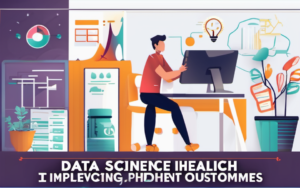The world of education is undergoing a profound transformation, fueled by the power of data science. Data Science Education is no longer just a buzzword; it’s becoming a reality, reshaping the way we learn, teach, and manage educational systems. With vast amounts of data being collected from students, teachers, and institutions, we now have the opportunity to analyze patterns, identify trends, and make data-driven decisions that can improve learning outcomes for everyone.
The Rise of Data-Driven Education
The integration of data science into education is paving the way for a more personalized, efficient, and effective learning experience.
Personalized Learning Experiences
Imagine a learning environment where every student receives a customized curriculum tailored to their individual needs and learning styles. Data Science Education empowers this vision. By analyzing student performance data, learning patterns, and preferences, educators can create personalized learning paths that cater to each student’s unique strengths and weaknesses. This personalized approach allows students to progress at their own pace, focusing on areas where they need extra support while accelerating in areas where they excel. Platforms like Khan Academy and Duolingo use data science to create adaptive learning experiences that adjust to a learner’s progress, providing personalized feedback and recommendations.
Predictive Analytics for Student Success
Data science tools can be utilized to predict student success, identify at-risk students, and intervene early to provide targeted support. By analyzing factors like attendance, grades, and engagement levels, educators can identify students who may be struggling and provide them with the necessary resources and guidance. Predictive analytics can also help identify students who are likely to succeed but may require additional challenges to stay motivated and engaged.
Optimizing Educational Resources
Data Science Education allows us to optimize the allocation of educational resources based on data-driven insights. By analyzing data on teacher workload, student enrollment, and resource utilization, administrators can identify areas where resources are being overutilized or underutilized and make adjustments accordingly. This data-driven approach ensures that resources are allocated efficiently, maximizing their impact on student learning.
Data Science Tools and Techniques in Education
The application of data science in education is made possible by various tools and techniques that provide powerful insights into the learning process.
Machine Learning for Adaptive Learning Platforms
Machine learning algorithms are at the heart of adaptive learning platforms, enabling them to personalize the learning experience for each student. These algorithms analyze data on student performance, interactions, and preferences to create tailored learning paths, provide targeted feedback, and recommend relevant resources. Machine learning models can also be used to predict student performance and identify areas where they may need additional support.
Natural Language Processing for Text Analysis
Natural Language Processing (NLP) techniques are used to analyze textual data like student essays, teacher feedback, and online discussions. NLP algorithms can identify key themes, sentiment, and writing patterns, providing valuable insights into student learning and understanding. These insights can be used to improve teaching strategies, personalize feedback, and enhance student engagement.
Data Visualization for Educational Insights
Data visualization tools play a crucial role in making complex educational data easily understandable and accessible. By presenting data in graphical formats like charts, graphs, and maps, educators and administrators can quickly identify trends, patterns, and outliers that might not be readily apparent in raw data. Data visualization helps to communicate insights effectively, enabling informed decision-making and driving positive change in education.
Benefits of Data Science in Education
The integration of data science into education offers a wide range of benefits, leading to a more effective and equitable learning environment.
Improved Student Outcomes
Data-driven insights can lead to improved student outcomes, including increased academic achievement, higher graduation rates, and improved career readiness. By identifying students who are struggling and providing them with targeted support, educators can help them reach their full potential. Data-driven interventions can also be used to personalize learning experiences, making education more engaging and effective for all students.
Enhanced Teacher Effectiveness
Data Science Education provides teachers with valuable data-driven insights that can enhance their effectiveness in the classroom. By analyzing student performance data, teachers can identify areas where students are struggling and adjust their teaching strategies accordingly. Data can also be used to provide personalized feedback to students, helping them to understand their strengths and weaknesses and make progress towards their learning goals.
More Equitable Access to Education
Data science can help to create a more equitable education system by identifying and addressing disparities in access to resources and opportunities. By analyzing data on student demographics, performance, and resource allocation, educators can identify areas where students are being underserved and develop targeted interventions to improve equity.
Challenges and Ethical Considerations
While data science offers tremendous potential for transforming education, there are also challenges and ethical considerations that need to be addressed.
Data Privacy and Security
The collection and use of student data raise important concerns about privacy and security. It is crucial to ensure that student data is collected, stored, and used responsibly, with appropriate safeguards in place to protect their privacy. Transparency and informed consent are essential when collecting and using student data, and students should have the right to access and control their own data.
Bias in Algorithms
Algorithms used in data science applications can perpetuate existing biases if they are trained on data that reflects societal inequalities. It is essential to be aware of potential biases in algorithms and to take steps to mitigate them. This includes using diverse datasets for training algorithms, ensuring that algorithms are evaluated for fairness, and developing mechanisms for addressing algorithmic bias.
The Role of Human Interaction
While data science can provide valuable insights, it is important to remember that education is fundamentally a human endeavor. Data should not replace human interaction and judgment. Teachers and educators play a vital role in providing guidance, mentorship, and emotional support to students, and this human element is essential for effective learning.
The Future of Data Science in Education
The future of data science in education is bright, with emerging technologies and trends poised to further revolutionize the learning landscape.
Emerging Technologies and Trends
Artificial intelligence (AI), machine learning, and virtual reality (VR) are among the emerging technologies that are expected to play an increasingly important role in education. AI-powered tutors can provide personalized instruction and feedback, VR can create immersive learning experiences, and machine learning algorithms can analyze large datasets to identify patterns and trends.
The Importance of Data Literacy
As data science becomes increasingly integrated into education, it is essential that students and educators develop data literacy skills. Data literacy encompasses the ability to understand, interpret, and use data effectively. This includes critical thinking skills, data analysis techniques, and the ability to evaluate the quality and reliability of data sources.
Building a Data-Driven Culture in Education
To fully realize the potential of data science in education, it is essential to build a data-driven culture in schools and institutions. This means fostering a culture of data-informed decision-making, encouraging the use of data to improve teaching and learning, and providing educators with the training and support they need to utilize data effectively.
The integration of data science into education is transforming the way we learn, teach, and manage educational systems. By embracing data-driven insights, we can create a more personalized, efficient, and equitable learning environment for all students. As we move forward, it is essential to address the challenges and ethical considerations associated with data science in education, ensuring that technology is used responsibly and ethically to empower learners and improve educational outcomes. By building a data-driven culture in education and fostering data literacy skills, we can harness the transformative power of data science to create a brighter future for education.




